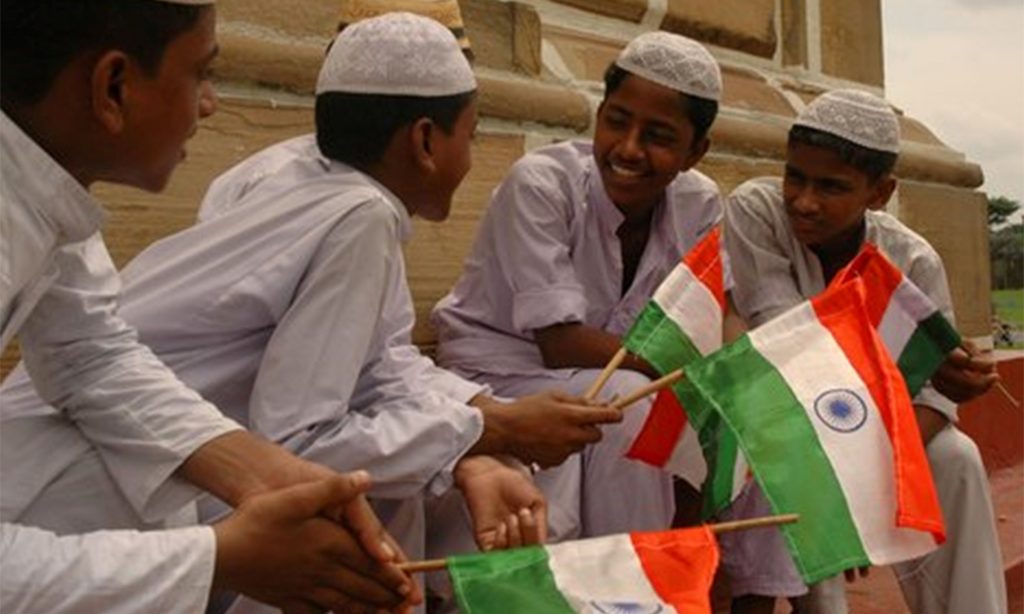
Parallel to the spotlight on the rise of the saffron in the Indian state of Uttar Pradesh (UP), Indian Muslim minorities have also been in discussion for various related reasons. This whole issue of how Indian nationalism is constructed reappears in the process. Although it’s mostly the issue of development on which the BJP got its mandate in the general and state elections, including in the populous and politically important UP, the question of Hindu nationalism and Ram Mandir keeps resurfacing – thanks to Indian media and the over-enthusiastic liberals who, unwisely or inadvertently, raise the issue more than the saffron politicians. The Hindutvavadis seem gleeful. The all-inclusive Gandhian territorial nationalism appears to be in decay. Thus comes forth the bigger question, how should a sustainable nationalistic narrative in India be chalked out?
The modern nation-state is clearly not the right kind of political vehicle for multi-ethnic or multi-communal countries like India for the sheer vastness of diversity which makes it impossible to construct a narrative like that of ethnic nationalism. Yet there is a desire for India, this gigantic post-colonial country, to become a modern forward-looking state. Since there was no pre-modern common political solidarity with traceable continuity to the modern era the only alternative was weaving of an all-inclusive modern nationalism which is instrumental in building the state and a pluralistic society. It had to be, and it was, by and large, a territorial nationalism with some loose reference to ancient and medieval India. That’s what the founding fathers of Indian nationalism did for several decades before 1947. It served its purpose in gaining independence from the British.
Vilifying Indian Muslims and the rulers of medieval India to create a bogey for the present has been a consistent tactic of Hindu nationalists
This secular nationalistic narrative of ‘unity in diversity’ worked reasonably well in India for many decades despite the birth of Pakistan alongside the former and kept the regressive Hindu nationalists at bay. Hindu nationalism of BJP and its precursors stressed on the majoritarian Hindu nature of India—drawing pride from the ancient Vedic civilisation. Their prime aim is to artificially homogenise, under Vedic and post-Vedic threads, the diverse Hindu society of many languages, customs, traditions, occupations and varied religious practices. To that end vilifying Indian Muslims and the rulers of medieval India to create a bogey for the present has been a consistent tactic. But it couldn’t compete until the early nineties with the rational Indian nationalism propounded by Congress and other secular parties.
Hindu nationalism only found some steam since the mid-eighties for a combination of reasons, e.g. constitutional amendment following the Shah Bano case, insurgency in Kashmir and expulsion of Kashmiri Hindus from the valley, etc, which allowed these nationalists to successfully propagate that Muslims are being appeased in India, despite the very different ground reality in terms of the huge overall backwardness of Muslims socio-economically.
The phenomenon of Islamic terrorism worldwide and some incidents in India over time have helped them to maintain that tone through the first decade of the new millennium into the second. However, that too exhausted some of its possibilities and hence invocation of ‘development’, following Modi’s economic success in Gujarat, as the lead issue and packaged craftily with implicit Hindutva. In modern electoral polity it’s difficult for any charismatic politician to have a continuous life of more than a decade. UPA of Sonia-Manmohan alliance has lived its life and a moderate development-oriented charismatic Modi became the darling alternative of capitalist India and Indian media. That’s the Modi wave. It’s likely to last a decade unless Modi and Finance Minister Arun Jaitley pull off something extraordinary.

The success in UP state election is the continuation of this Modi wave with a more crafty caste-communal strategy i.e. exclude and vilify Muslims, Yadavs and Jatavs and aim for the rest 70 percent. Divisiveness, polarisation and majoritarian consolidation under implicit Hindutva on one hand and Modi mantra of development on the other. They got about 40 percent of the vote and three-fourth of the seats thanks to first-past-the-post system rather than proportional representation. In 2019 Modi will still be the ‘development messiah’ across India and Yogi Adityanath is expected to deliver a crucial percentage of votes of the religious Hindu in UP which has 80 parliamentary seats.
There are a few common allegations at the saffron level directed at Muslims. One is that the Muslims receive special treatment in India. In reality, the facts are on the contrary. Muslims are the most backward community. For example, even the scheduled caste Hindus, who are considered most backward, have government jobs very close to their population percentage whereas Muslim representation at government jobs is less than a third of their population share. The other major allegation is that the Muslim population in India has increased and Muslims will surpass Hindus in the near future. Muslims are just 14 percent of India’s population now whereas Hindus constitute more than 80 percent. Muslims had a relatively higher growth rate than the national average which is decreasing in recent years. It is a proven fact that socio-economically backward social groups have higher population growth rates. By the same logic, the Scheduled Castes (SCs)/Scheduled Tribes (STs) populations have increased in higher rates. It’s true that Muslims have grown from 10 percent of India’s population to 13 percent in the last six decades and similarly the backward SC/ST Hindus have grown from 18 to 24 percent. BJP never brings that up as they also target SC/ST vote in the name of Hindu unity. But they have been significantly lifted socio-economically due to affirmative action i.e. reservations in government jobs and parliamentary seats as per population percentage. Muslims are rather discriminated against and despite similar social backwardness the same was not extended to them.
In 2019 Modi will still be the ‘development messiah’ across India and Yogi Adityanath is expected to deliver a crucial percentage of votes of the religious Hindu in UP which has 80 parliamentary seats.
The BJP repeatedly call the Congress, the Left and other secular parties as pseudo-secularists, claiming that they are the ‘real seculars’. But they hardly talk about the core issues Muslims are facing. In the end, it has to be the pragmatic section of Indian Muslim leadership and the secular political parties who need to find a way to address Muslims’ issues alongside issues of the other backward groups without making it a constant talking point and thus falling into to BJP’s propaganda trap.
Now that the Modi-Amit Shah duo has nominated a more conservative Hindu priest-turned-politician Yogi Adityanath as the Chief Minister of Uttar Pradesh, the over-enthusiastic English-speaking urban liberals, who hardly have any sense of ground reality, and the media have started talking about Ram Mandir even before Adityanath himself. Ram Mandir though is a sensitive and special case on many counts. The BJP has milked the issue to its huge political benefit in the nineties and has kept it alive over the years. However, there is also some pressure on them from some religious Hindu sections to deliver on it. It’s yet to be seen whether they push the issue hard this time or not.
All India Muslim Personal Law Board, on behalf of the Indian Muslims, has done well to put up a fierce legal and counter-propaganda fight on the matter over the past several decades, with tacit support from the secular parties, to wear down the saffron enthusiasm on the matter to a considerable extent. But the enthusiasm hasn’t died down and the movement might get rejuvenated because of people like Adityanath.
The Muslim position on Ram Mandir was more of a principle rather than emotional as Muslims haven’t prayed in Babri Masjid since 19th century unlike the Hindus. Muslims are concerned that if Babri Masjid is conceded due to pressure then the religio-political Hindus will start demanding for more places of worship of the Muslims where they have some claims and the logic may even be dangerously extended to many other areas. However, some argue that the specialty of Ram Janmabhoomi and Ram Mandir is that Lord Rama occupies a unique place in Hinduism and hence it could just be a one-off sentimental issue. Also, historically and archeologically, it has been proven that there were some Hindu structures related to Lord Rama in the place of Babri Masjid before the latter’s construction and even after the mosque was built, probably during Aurangzeb’s time, Rama’s birth festival and worshipping of Rama continued for a substantial period of time outside the mosque, but within the complex .
There is still an opportunity to solve the matter mutually as the high court has granted one-third of the disputed land to Muslim Sunni Waqf Board and rest to two Hindu groups and the matter is now pending in Indian Supreme Court. Many liberal Muslims are talking about generously letting the Babri Masjid land go to the Hindus as a gesture of inter-communal harmony so that religious Hindus can construct their long cherished Ram Mandir there and thus kill this unique issue once and for all, denying BJP to politically milk it anymore which is more harmful for the Muslims than holding on to that small piece of land. This sounds like a more pragmatic option and it will allow the Muslims to focus on their urgent socio-economic issues.
The BJP talks of ‘Indianness’, ‘nationalism’, ‘liberal traditions of Hinduism’, etc, but if delved into deeper their parochial worldviews can be unearthed. A major part of the narrative of the BJP-Sanghi politics on contemporary issues is more reactionary and hardly principle-based. They criticise Islamism, but in turn behave in the same way of discrimination and hatred. They condemn the social and political culture of Pakistan yet emulate it. India has attained a special place globally as a developing-world democracy, in fact the largest democracy in the world, with some strong modern liberal ideals, and the BJP is out there to redefine it and is in the process degrading it.
Their constructions refer to Hindu traditions of tolerance, but they hardly imagine Muslims and the followers of other religions in them as a rightful equal member. They draw from history, yet they either despise or ignore the good things of medieval India where Muslim rulers built better administrative systems, practised gradual inclusion of all communities in the ruling class even in those times and patronised architecture, spirituality, music, literatures, fine arts, etc. Their only interest is in pre-Islamic Vedic India and they childishly and arrogantly claim the ancient mythologies as ‘science’ and ‘advancement’. They retrospectively try to invent new glories and propagate those. Even textbook contents are changed and saffronised. Settled issues like limited cow slaughter, beef consumption, inter-communal marriage, etc, are being challenged including state intervention in minority personal laws. All these indicate towards a dangerous trend of degeneration from the solid base of Nehruvian liberal order. True that the BJP government is working towards more investments, manufacturing and some regulatory reforms but good in some areas of governance can’t make up for fundamental deteriorations in the areas of social and political values and settlements.
BJP is a political reality in India and the seculars and minorities have to learn to deal with this phenomenon.
The most unfortunate thing of party politics in India is the failure of Janata Dal to put up a viable alternative to Congress in 1977 and to some extent in 1989. Would that have happened it would have been the long-term alternative to Congress instead of BJP. However, BJP is a political reality in India and the seculars and minorities have to learn to deal with this phenomenon.
BJP, of course, isn’t entirely like the theocratic Islamist political outfits because there is no pre-existing and complete theory of state in Hindutva doctrines. It also adopts pragmatic flexibilities at times. There is a possibility that when in power it will become a little moderate. Also, there is a moderate and educated stream of leadership in it alongside the Sanghis. When it shows the tendencies of moderation the civil society and liberal media should allow and appreciate the metamorphosis of at all.
The political social leadership of the Indian Muslims disproportionately stressed more on preservation of orthodoxy among Muslims in fear that their faith and identity might get diluted in Hindu-majority India. Their lack of interest in education and socio-economic advancement of fellow community men and women for long has led to the dismal state of affairs of the Muslims.
The idea of Pakistan, although depicted at that time as a salvation course for Muslims, was actually a disaster for sub-continental Muslims, especially the huge segment who were to be left behind in India. It split the community into three. The Muslim political leadership demanded a country on the basis of Muslim nationhood which effectively had to leave out one-third of it to the country from which it was seceding. Muslims were close to 30 percent of undivided India’s population and they got 20 percent of undivided India’s land in two extreme ends which inevitably split into two in 1971 with the independence of Bangladesh putting a death nail to the much romanticised ‘two nation theory’. The same was not entirely applicable to the Hindus due to their smaller percentage in Pakistan and India’s ability to absorb the partition refugees due to its vastness. Most importantly, Pakistan’s deterioration to a semi-civilised quasi-theocracy fraught with intolerance towards minorities and widespread persecution of the same eventually forcing them to leave for India and recent state-sponsoring of anti-India Islamic militants have made the situation difficult for Indian Muslims who are the third largest Muslim community in the world after Indonesia and Pakistan with a mammoth size of about 170 million. Also, the phenomenon of global Islamic terrorism and radicalisation are also putting the Indian Muslims on the back foot indirectly.
It’s about time for the Muslims to take lesser interest in religious orthodoxy… instead be more united in achieving socio-economic advancement and being integrated into mainstream Indian society
It’s true that the secular parties in India used Muslims as vote banks and hardly has done anything for their real advancement. All these have resulted in this phenomenon of widespread poverty among the community including lack of education, increase of population despite the lack of economic means, etc. Perhaps it’s about time for the Muslims to take lesser interest in religious orthodoxy, looking abroad to the Ummah, hypersensitivity about identity, vote-bank politics, and instead be more united in achieving socio-economic advancement and being integrated into mainstream Indian society which is already diverse and generally accommodative of community distinctiveness to a certain degree. When it comes to politics, whichever party addresses the core socio-economic issues of the community, Muslims should be open to embrace them and not be a traditional voting block of one or two parties. The secular parties should engage Indian Muslims on their key issues – not just in terms of symbolism and lip service. Also, Indian Muslims should get organised under progressive voices rather than the regressive Ulemas and start working for themselves instead of just looking up to the political class to do something.







